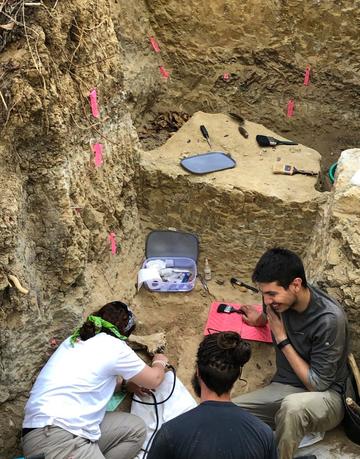
Susana Carvalho, João Coelho and Thomas Püschel excavating Miocene fossils in Gorongosa National Park during the 2019 field season
Where, when and why did hominins arise? Although intrinsically difficult, contextualising early hominin evolution within a well-established spatial and temporal ecological framework represents one of the fundamental ways of answering these essential palaeoanthropological questions. Climatic and environmental factors are strong drivers of evolution, and it is expected that these processes played a central role in hominin evolution. Consequently, several hypotheses have been advanced to relate climate and environmental fluctuations with important events in the evolution of the human lineage. However, many of these hypotheses are limited by the biogeographic gap dividing South and East African paleontological sites located in the East African Rift System (EARS). Even though this area has crucially contributed to our understanding of vertebrate and human evolution in the late Cenozoic of Africa, the distribution of fossil sites along the rift is extremely biased towards its northern areas, and the types of palaeoenvironments are predominantly circumscribed to fluvial and lacustrine locations. Fortunately, the situation is now changing as a consequence of the finding of several fossiliferous sites located within Gorongosa National Park, Mozambique at the southernmost point of the EARS. Fossils from these sites comprise dicot trees, palms, invertebrates, reptiles, fishes, invertebrates, and mammals including possible primates. This emerging fossil record, as well as the sedimentological reconstruction of this location, suggest a palaeoenvironmental mosaic of estuarine-riverine forest/woodland systems, thus representing the first coastal Miocene habitat identified in the EARS. This unique setting can allow us to assess currently untested hypotheses such as those that predict that hominoids originated in coastal forest settings, as well as those proposing that deltaic components were fundamental during human evolution. The emerging mammalian record from these areas can certainly provide fundamental information about the interaction of environmental change and mammalian evolution, including processes that likely affected hominin evolution. Fossil mammals represent a unique source of information about the Earth’s past, since individual species and entire assemblages can expose the distinctive characteristics of the mammalian community in a given place and time, thus playing a fundamental role in our understanding of how lifeforms evolved in different settings over geological time. During the 2019 field season in Gorongosa, more than 400 fossils were found. Post-Doctoral Fellow, Dr Thomas Püschel, the project lead, is currently describing and identifying these new fossil findings, as well as comparing them with Miocene fossil materials from other African regions. This will provide key data to evaluate hypotheses regarding the capacity of such habitats to drive mammalian, primate, and hominin evolution. This project is funded by the Leverhulme Trust and Boise Trust.
This project is a collaboration with: Susana Carvalho, René Bobe, João Coelho, the Paleo-Primate Project Gorongosa.